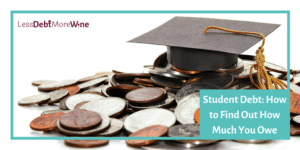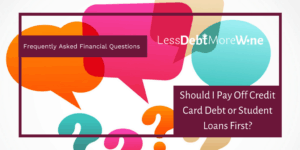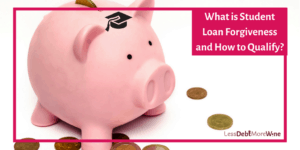How Student Loans Get Forgiven
THIS POST MAY CONTAIN AFFILIATE LINKS. MEANING I RECEIVE COMMISSIONS FOR PURCHASES MADE THROUGH THOSE LINKS, AT NO COST TO YOU. PLEASE READ MY DISCLOSURE FOR MORE INFO.
Student loans can get forgiven in a number of ways.
One way is if you work for a certain amount of time in a public service job. Another way is by going into a particular type of teaching program.
There are also other ways to have your student loans forgiven, but they vary depending on the situation.
Differences Between Forgiveness, Cancellation, and Discharge
It’s important to understand the difference between forgiveness, cancellation, and discharge of your student loan.
Forgiveness means that you are no longer required to repay your loan.
Cancellation means that your loan is no longer in existence and you are not responsible for repaying it.
Discharge means that you are released from your obligation to repay your loan, but the loan still exists.
There are several ways that student loans can be forgiven, canceled, or discharged.
Related: Certain Private Student Loans May be Dischargeable in Bankruptcy
Public Service Loan Forgiveness
The Public Service Loan Forgiveness Program is a federal program that forgives student loans for borrowers who are employed in public service jobs.
To be eligible, borrowers must make 120 qualifying monthly payments on their student loans while working full-time in a public service job. Though these payments do not have to be consecutive.
After making the required payments, the remaining balance on the loan is forgiven.
Teacher Loan Forgiveness
The Teacher Loan Forgiveness Program is a federal program that forgives student loans for borrowers who are employed as teachers in certain types of educational settings.
To be eligible, borrowers must teach full-time for five consecutive years and the maximum amount forgiven is either $5,000 or $17,500 depending on the teacher’s subject area.
The different types of student loan forgiveness programs available via Income-Driven Repayment Plans
Income-driven repayment plans allow borrowers to pay back student loan debt over a period of 1 20 or 25 years. With their monthly payments being determined by what they can afford to pay.
The length of the plan depends on the type of federal student loans they have. After making the payments the rest of the loans are “forgiven”.
However, the way the law currently stands, that “forgiven” amount is considered taxable income so they may end up with a big tax bill depending on how much is forgiven.
Thought the Biden administration has proposed having the government cover unpaid monthly interest so that the loan balance won’t grow over time, even when a person’s monthly payment is $0.
Related: FAFQs Series: Will My Student Loans Really Be Forgiven?
How to Apply for Different Repayment/Recertification
In order to enroll in an income-driven repayment plan you must, submit a plan request, and continue to recertify each year for every single loan servicer you have.
To get started you can visit the website for the Department of Education’s Office of Federal Student Aid to learn more about the different types of repayment plans that are available.
If you are having difficulty making your student loan payments, you may want to consider applying for a repayment plan. A repayment plan allows you to extend your repayment term and lower your monthly payment amount. There are several different types of repayment plans available, and you will need to contact your student loan servicer to see if you are eligible for any of them.
If you are enrolled in an income-driven repayment plan, you will need to recertify your income and family size each year. You can do this by submitting the required documentation to your student loan servicer. If your income or family size has changed, you may be eligible for a different repayment plan.
Finally, if you are having trouble making your payments even on an income based repayment plan you can reach out to your loan servicers to request a loan forbearance or deferment.
What are the eligibility requirements for student loan forgiveness?
The eligibility requirements for student loan forgiveness vary depending on the type of program you are applying for.
For example, the Public Service Loan Forgiveness Program requires that borrowers make 120 qualifying monthly payments on their student loans while working full-time in a public service job.
The Teacher Loan Forgiveness Program requires that borrowers teach full-time for five consecutive years in a low-income school or educational service agency.
It is important to research the different types of student loan forgiveness programs before you decide which one is right for you. You can learn more about the different programs by visiting the website for the Department of Education’s Office of Federal Student Aid. You can also contact your student loan servicer to see if you are eligible for any type of student loan forgiveness program.
What are the drawbacks of having your student loans forgiven
There are a few drawbacks to having your student loans forgiven. For example, if you have your loans forgiven through an income-driven repayment plan, you may have to pay taxes on the amount that is forgiven.
However, the same is not true for loans forgiven under Public Service Loan Forgiveness.
Another drawback of student loan forgiveness is that it may not cover all of your student loans. For example, if you have private student loans, you will not be able to get them forgiven through any of the federal student loan forgiveness programs.
How to apply for student loan forgiveness
The first step in applying for student loan forgiveness is to contact your student loan servicer. You will need to provide them with information about your job, income, and family size.
They will then be able to tell you if you are eligible for any of the different repayment plans or forgiveness programs.
If you are eligible for a repayment plan, you will need to submit an application to your student loan servicer. This application will ask for information about your income and family size. You will also need to provide ongoing documentation throughout the life of your loans.

What to do if your application is denied
If your application for student loan forgiveness is denied, you will remain responsible for repaying your loans.
You may also consider consolidating your student loans. This will allow you to make one monthly payment on your loans instead of multiple payments. You may also be able to lower your interest rate by consolidating your loans.
Alternatives to student loan forgiveness
If you are not eligible for student loan forgiveness, there are other options available to help you repay your student loans. You may be able to consolidate your loans.
Or if you can afford it, you can refinance federal loans with a private lender at a much lower interest rate. You will need to have good credit in order to qualify for a refinanced loan.
You can also try to negotiate a lower monthly payment with your student loan servicer. This may be an option if you are having difficulty making your monthly payments
The Botton Line
Student loan forgiveness is a great way to reduce the burden of paying off your student loans. However, there are some drawbacks and only certain loans will qualify for these programs.
If you don’t qualify you might look at either consolidating or refinancing your student loans to decrease the number of loan servicers you have and possibly save money on interest.
Frequently Asked Questions
Do you still have questions about how student loans get forgiven? We’ve answered the most common questions below.
How much of a student loan can be forgiven?
The amount of student loan forgiveness varies depending on the program that you are enrolled in. For example, the Public Service Loan Forgiveness Program forgives up to 100% of your remaining student loans. While the Teacher Loan Forgiveness Program forgives up to $17,500 of your student loans.
Income-driven repayment plans will forgive up to 100% of the remaining balance at the end of the 20 or 25 year repayment plan, but you may be subject to paying taxes on the forgiven amount.
What is the difference between student loan consolidation and student loan refinancing?
Student loan consolidation allows you to combine multiple student loans into one loan. Student loan refinancing allows you to get a new loan, typically with a private lender (which doesn’t offer the different payment plans or flexibility that federal loans provide).
Does student loan forgiveness affect credit score?
Potentially, it will lower your mix of credit, but also decrease your amount of debt. It depends more on if during repayment you made payments on time.
Are student loans automatically forgiven after 25 years?
No, student loans are not automatically forgiven after 25 years. You must apply for forgiveness for federal student loans through an income-driven repayment plan or another program.
What is the difference between an income-driven repayment plan and student loan consolidation?
An income-driven repayment plan allows you to make monthly payments based on your income. Student loan consolidation allows you to pay back all of your outstanding student loans over a set period of time to a single loan servicer.
Can student loan debt be forgiven when on disability?
Yes, student loan debt can be forgiven when you are on disability. You can apply for the Total and Permanent Disability Discharge through the Department of Education. You will need to provide documentation proving that you are disabled.
Do I need to pay taxes on student loan forgiveness?
It depends on what program the loans were forgiven. Under Public Service Loan forgiveness you would not need to pay taxes on student loan forgiveness. The amount of your forgiven student loans will not be considered taxable.
However, for loans forgiven through an income-driven repayment plan, you may be required to pay income tax on the amount forgiven.




